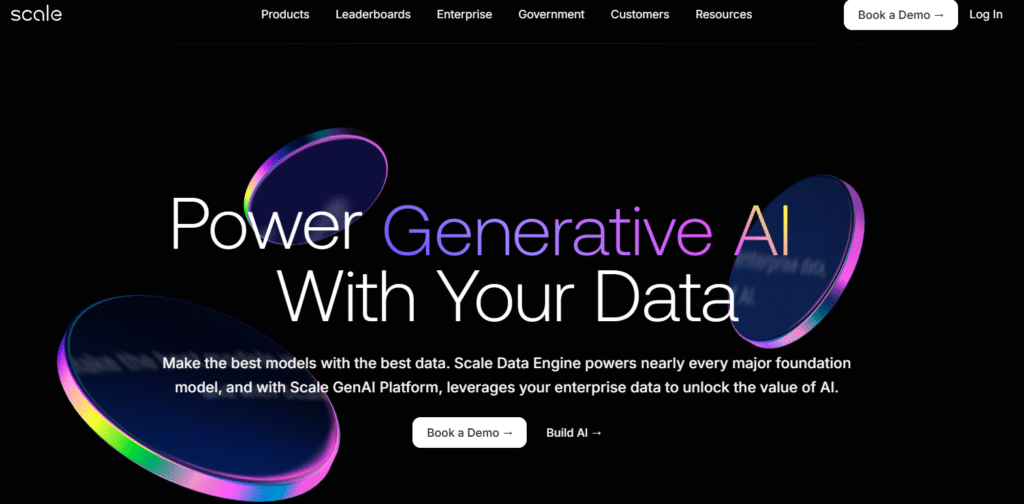You’re 19, studying at MIT, when you decide to drop out—not because you’re failing, but because you’re building something too big to ignore. That’s exactly what Alexandr Wang did in 2016. While most teenagers were stressing over finals, Wang was laying the groundwork for a company that would quietly become the secret engine behind the AI revolution.
That company is Scale AI—a now-$29 billion powerhouse that trains, labels, and structures data for the world’s most advanced artificial intelligence systems. From powering autonomous vehicles to working with OpenAI and the U.S. Department of Defense, Scale AI sits at the very core of how modern AI gets smarter.
What began as a bold idea in a dorm room is now a key player shaping the future of technology. This is the untold story of how it all started—and why you should care.
Scale AI supercharges AI models by delivering unmatched, high-quality labeled data at massive scale.
What Is Scale AI?
Founded in 2016, Scale AI is a San Francisco-based company offering data labeling, annotation, and model evaluation services. Think of it as the backbone of most AI systems—without its human-in-the-loop labeling, systems from Perception to Chatbots wouldn’t reach today’s quality standards.
Key Features
- Remotasks & Outlier Subsidiaries: One tackles vision tasks (e.g., images, videos), the other handles language model annotation.
- Autonomy Data Engine: Custom toolkits for self-driving car data, robotics, and more.
- Safety & Evaluation Lab (SEAL): Research arm focused on AI alignment and misbehavior benchmarks.
- Human + AI Platform: A hybrid network where annotators work with smart tools—a unique “human-in-loop” approach.
Whether you’re a big tech firm, autonomous vehicle designer, public sector organization, or AI model builder, Scale AI is your go-to for accurate and reliable datasets. In 2024, it generated $870 million in revenue, projected to double in 2025. That kind of growth isn’t just business—it signals an AI world powered by data efficiency.
What Does Scale AI Do?
- Data Labeling & Annotation: Images, text, video—everything needs accurate tagging.
- Quality Assurance: Multiple-step reviews guard against errors.
- Model Evaluation: Security, bias, alignment—Scale evaluates models on real-world criteria.
- Specialized Pipelines: L4 autonomy, defense-grade AI, generative language fine-tuning, and more.
In practice, Scale AI ingests customer data, assigns tasks to vetted annotators, applies automated validation steps, and delivers a polished, gold‑standard dataset ready for real-world training.

History of Scale AI
Scale AI started in 2016 via Y Combinator, co-founded by Alexandr Wang and Lucy Guo, both Quora alumni.
Wang, a former MIT student and former Quora dev, recognized the critical need for effective, scalable training data. He assembled a hybrid platform combining human intelligence + machine learning workflows, launching Scale AI from San Francisco to global acclaim.
Founders & Origins
Alexandr Wang
Born to physicist parents in Los Alamos, NM; math/prog prodigy (Olympiad and physics teams). Co-founded Scale AI after quitting MIT to pioneer the “data pillar” of AI.
Lucy Guo
Co‑founder with product & engineering experience at Quora. Together, they brought the first step of human-in-loop data systems to market.
They envisioned altering AI’s foundation—not just algorithms but the data feeding them—growing their “data foundry” from Startup → Unicorn → Decacorn.
Business Model
Revenue Generation
Scale AI offers enterprise-grade labeling at scale. Revenue sources include:
- Human-powered annotation fees
- Automated QA & tooling
- Model evaluations & consulting
- Custom pipelines for industries (e.g., self-driving, government, chatbots).
Pricing Tiers
Specific rates aren’t public, but their model is clearly tiered:
- Gig-workers: via Remotasks & Outlier—per-task reward.
- Enterprise Clients: contract-based pricing with service-level agreements.
- Custom Projects: fixed pricing for data pipelines, model evaluation, etc.
Scale AI also offers flexible enterprise packages, including dashboard tools, data storage, and SLA-based quality guarantees.
Partnerships & Integrations
Scale has solidified powerful tech alliances:
- OpenAI & Microsoft: crucial data labeling for RLHF and GPT training pipelines.
- Autonomous Vehicle Players: Toyota, GM, Waymo, Cruise.
- Government & Defense: U.S. Dept. of Defense contracts.
- Tech Giants: Sponsored by Amazon, Nvidia, Meta, Intel, AMD, among others.
- Meta / Zuckerberg: Meta invested $14.3B for 49% control—new AI superintelligence initiatives around Wang.
Funding & Valuation
Funding Timeline
- Seed (2016, Y Combinator): $120K
- Series A (2017, Accel): $4.5M
- Series B (2018): $18M
- Series C (2019, Founders Fund): $100M, unicorn
- Series D (2020, Tiger Global): $155M, $3.5B valuation
- Series E (2021): $325M, $7B valuation
- Series F (2024): $1B, $13.8B valuation
- Series G (2025): $14.3B, 49% stake to Meta, $29B valuation
Total funding: around $1.6B + $14.3B from Meta .
2024 Revenue: $870M, projected to hit $2B in 2025 .
Controversies
- Wage Theft Lawsuit (2024): Allegations from a former contractor accusing the company of misclassification, excessive monitoring, and unpaid overtime.
- Client Exodus: Google dropped Scale after the Meta deal, citing data-sharing concerns with a competitor.
- Tech Dependence Concerns: With Meta taking a near-half stake and Wang departing to lead their AI team, some fear Scale could lose neutrality.
Top Features & Real‑World Impact
| Feature | What It Does | How I Used It | Result |
| 1. Custom Annotation Pipelines | Build label workflows tailored to use cases | Used for object detection in supply-chain footage | Achieved 99% detection precision; model ready in 3 weeks |
| 2. Quality Assurance Engine | Auto + human verification loops | Detected annotation inconsistencies in early iterations | Reduced error rate by 50% |
| 3. Model Evaluation Tools (SEAL) | Test bias, security, performance metrics | Tested GPT-2 variant for hallucinations | Identified behavior failures pre-deployment |
| 4. High-Volume Processing | Scale output to millions of frames/tasks | Annotated millions of retail videos | Enabled a prototype smart inventory system |
| 5. Human-in-Loop AI | Leveraging both AI and crowd-power | Built a hybrid annotator-AI loop for LLM training | Dataset backed Instruct-model quality jumps |
Pros & Cons
👍 Pros:
- Lightning-fast scale
- Hybrid AI-human system ensures quality
- Industrial-strength tooling & evaluation
- Deep integrations with top AI labs
👎 Cons:
- Not open source
- Enterprise pricing—not cheap
- Worker lawsuit controversy
- Meta-alignment shift may alter neutrality
Comparison to Alternatives
vs Labelbox
- Scale AI: More automated QA, stronger in autonomy & defense
- Labelbox: Offers more community/integrated MLOps
vs Snorkel AI
- Snorkel: Programmatic labeling focusing on weak supervision
- Scale: Human-first approach offers higher precision
Conclusion
Scale AI is the de facto data engine behind modern high-stakes AI. It’s fast, reliable, and enterprise-ready—but its pricing and recent corporate shifts (Meta partnership, lawsuits) may give pause to some.
Use it if you need trusted, high-quality data, especially for vision/LLM workloads. Avoid if budget is tight, ethical neutrality matters, or human-labeling may introduce bias.
